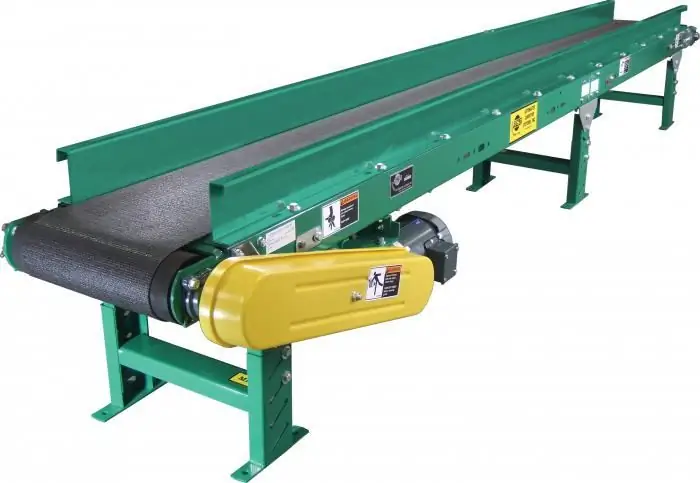2026 Author: Howard Calhoun | [email protected]. Last modified: 2025-01-24 13:10:26
Today it is difficult to imagine high-performance production without the use of a conveyor. To move goods, including bulk, use closed belts. We can say that this is a continuous unit, which has a load-bearing body (flexible tape). Let's take a closer look at what a belt conveyor is, what is its purpose, scope, and also what are the subtleties of operating this equipment.

Scope and purpose
Today it is one of the most promising modes of transport, which is almost indispensable for large cargo flows. In addition, the conveyor belt is an indispensable part of any heavy and light production. It is used in metallurgy, for transportation of bulk materials, in the food industry,medicine and so on. The principle of operation and the device in all cases are almost the same. Differences can be in the form of the belt, its load capacity and flexibility, as well as drive power. In most cases, this kind of conveyor allows you to partially automate production and reduce the amount of manual labor. With this in mind, the considered transported machines are subject to stringent requirements. For the most part, this is about the strength, performance and interchangeability of the worn belt. The units are capable of operating at temperatures ranging from -50 to +45, which is determined by the technical characteristics of the carrier body.

Operation and arrangement of the conveyor belt
Tape - the working body of the conveyor, pre-tensioned and connected. It is driven by friction between the belt and the drive drum. Moreover, the determining factor is the friction force, due to which the load-carrying and traction body moves. To prevent deflection of the belt along the length of the conveyor, roller supports are installed, on which it rests during movement. As you can see, the device of the unit is quite simple. An interesting point is the speed of replacing the worn tape. This is done as follows: during the operation of the conveyor at the docking point, the load-bearing body is steamed out and a new tape is attached to it, by riveting or vulcanization. After the drive drum makes a full cycle, the second end is fixed. This approach is good because there is practically no equipment downtime during operation, sinceinstallation is carried out in a few minutes, although much depends on the type of traction body. To clean the tape, brushes are installed, and centering rollers are used to avoid distortion. The design of the belt conveyor is such that the unit can be used in many industries. Now let's move on.
Benefits of using a conveyor belt
Let's look at the main advantages that this unit has. The main advantage of a belt conveyor is that it can be used to transport goods over a very long distance. In some cases, the length of the load-carrying body can reach 3-5 kilometers. No other pipeline can be so long. This is due to the large weight, complex design and, most importantly, the high cost of equipment. In the case of a belt conveyor, there are no problems. Another indisputable advantage is high performance. Sometimes the speed can reach 6-10 m / s, with a tape width of 2.4-3.0 meters. In this case, the productivity can exceed 20-30 thousand tons per hour. In addition, the belt conveyor belongs to the universal conveying lines. This is due to the fact that you can move a variety of goods. Another important advantage is the ability to move goods in an inclined position. With increasing angle and duration of the conveyor, its speed decreases.

Disadvantages of belt conveyors
It is worth saying that there are significant shortcomings that limit the scopethe use of transport devices of this type. The main disadvantage is the high price of the tape and rollers. In most cases, the traction and load-bearing body costs about 30% of the total cost of the installation, which is a lot. Although much here depends on the purpose, as well as technical characteristics (material, number of layers, etc.). Another drawback is that the belt conveyor drum drives the belt by friction. This limits the angle of elevation, so it cannot exceed 20 degrees. In addition, it is rather problematic to move dust-like cargoes, which can partially volatilize and crumble in the process of movement. It is difficult to work at too low temperatures, as well as at too high. Thermal impact will change the characteristics of the flexible tape, and also lead to destruction.

Operation of belt conveyors
As noted above, the LC can operate at high speeds. This makes the belt conveyor more productive than other conveying units. The main feature of operation is that it is possible to create complex routes. For example, you can make a complex route with bends, horizontal and sloping sections. Even under difficult operating conditions (temperature fluctuations, high dust content, etc.), the belt conveyor ensures reliable operation without failures. In most cases, with proper maintenance, it is possible to clearly predict the period of failure of the traction element. This allows you to operatedevice without downtime. To date, a huge number of drives have been developed that ensured the operation of the LC. When increasing the length, several engines are installed that ensure normal operation. When one drive exits, the second one will work. In this case, although performance will decrease, there will be no downtime.

Arrangement and design of the tension and drive station
The belt conveyor drive consists of a motor, a gearbox and several couplings. In places of bending, roller or deflecting batteries are installed, creating a smooth transition. The whole structure, together with the drive, is mounted on a foundation, which must be laid in advance. The drive station consists of a drive as well as a loading box, and the part where the tensioner and the loading funnel are located is referred to as the tension station. Between these two stations is the middle part of the conveyor, it is made of several linear sections. The latter consist of identical linear sections interconnected by bolts. And now let's talk about what kind of belt conveyors are and what is their fundamental difference. There are some interesting points here.
Classification of belt conveyors
There are some signs by which device data can be conditionally divided into several groups:
- by scope: there are general purpose, special and underground (transportation of people, reeling, and also mobile);
- according to the shape of the track:simple (with a straight section), complex (with an inclined broken line), as well as curvilinear or spatial (bend in the plane of the load-bearing body);
- in the direction of movement of the cargo: lifting and lowering;
- according to the shape of the belt and the placement of the load: there are flat and grooved belts in various modifications;
- according to the slope of the track: horizontal, inclined, steep (angle more than 22 degrees) and vertical.
It should be understood that, in addition, the belt conveyor scheme provides for the use of various traction and load-carrying bodies. Tapes are rubber-fabric, rubber-cable, wire, and also steel. The type of tape is selected based on the conditions in which it will work. For example, steel traction elements are used to work at high temperatures (up to 850 degrees), just like wire, which can transport loads at an operating temperature of 1100 degrees Celsius.

Mine conveyors
Separately, a few words need to be said about transporting devices operating underground. It is noteworthy that the scheme of this type of belt conveyor is somewhat different. The degree of reliability increases several times. This is due to the fact that the load-bearing body is used to transport people, as well as heavy piece goods, and all this is done in cramped conditions. The drive, for example, has two tension drums, which allows you to make the device not only more powerful, but also to ensure sufficient reliability.

Conclusion
Today, the popularity of belt conveyors is constantly growing. For this simple reason, new types of load-carrying bodies are constantly being developed. In particular, it is important to create high-strength heat-resistant parts. For example, it is necessary to increase the service life of rollers that constantly fail. We can say that the work of the belt conveyor is considered quite cheap. If you move cargo over a distance of up to 30 km using a LC, it will be much more economical than doing it by road.
Recommended:
Conveyor belts: overview, description, types. Rubber conveyor belt

Conveyor belts are one of the most common and convenient means for moving a product from one point to another. They are used in many industries, ranging from household industry to heavy engineering
Conveyor roller. Conveyor rollers - GOST

The roller is an important part for any conveyor belt. Its reliability and quality largely determine how well the machine itself will work, whether it is able to perform its functions. Conveyor roller can last from two to 15 years
Belt conveyors: history and stages of improvement

Belt conveyors are familiar to everyone today. These are extremely necessary and even irreplaceable mechanisms in many production processes. But when and where was the idea of mechanically moving goods over distances using a conveyor born? Let's try to look into the history of their birth
Turboprop engine: device, scheme, principle of operation. Production of turboprop engines in Russia

A turboprop engine is similar to a piston engine: both have a propeller. But in every other way they are different. Consider what this unit is, how it works, what are its pros and cons
Work permit for work in electrical installations. Rules for work in electrical installations. Work permit

From August 2014, Law No. 328n comes into force. In accordance with it, a new edition of the "Rules on labor protection during the operation of electrical installations" is being introduced

